Artificial Intelligence in diabetes Care : Research Paper
43 Pages11940 Words36 Views
Added on 2020-04-15
Artificial Intelligence in diabetes Care : Research Paper
Added on 2020-04-15
ShareRelated Documents
Project: Development of an Artificial Intelligence Chat Bot for
Diabetes Patients
Name
Date
Diabetes Patients
Name
Date
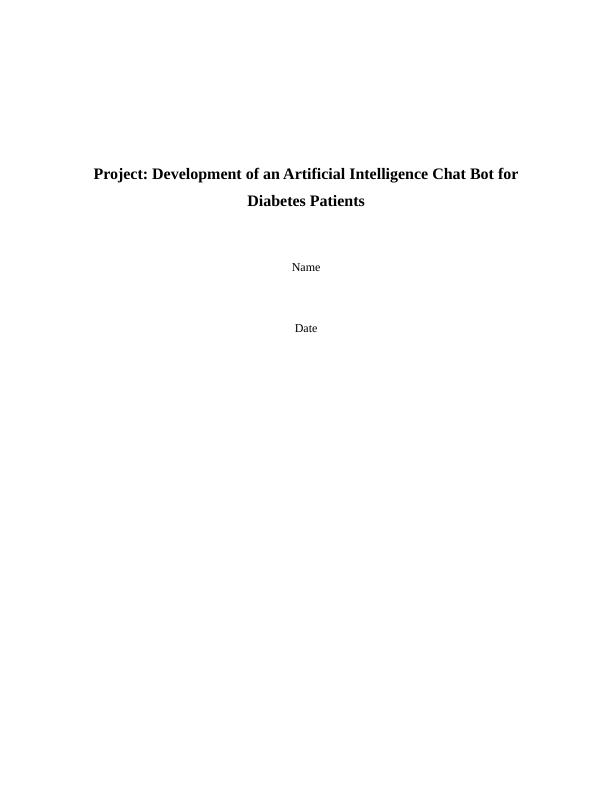
Abstract
This research paper proposes and develops an artificial intelligence diabetes chatbot that is a
health assistant to diabetic patients. The need for such a chatbot is informed by the tremendous
growth in technology use in health care and the challenges that face patients and physicians n the
effective management of the chronic condition of diabetes. Patients rarely have adequate
qualitative time with their doctors, with countries such as the US averaging just over one hour of
direct contact by patients with a physician. Yet counties continue sending significant amounts of
its GDP on health care, with the US using 17% of its GDP on health care for its citizens. Further,
diabetes management requires a lot of self-management by the patient to attain healthy lifestyles.
Some of the challenges faced in effective management of diabetes include not following
recommended lifestyles, high costs of insurance and payments for medicines, failure to follow
treatment regimes, and failure to monitor blood glucose levels regularly. Further, high costs and
compelling personal reasons, along with few doctor visits and doctor patient time have added to
the challenge of effective management of diabetes. Using the Internet and artificial intelligence
principles, this paper proposes the use of a chatbot that is developed with a library to become
diabetes patients’ personal assistants. A simple chatbot was built using the C++ language, using
the principles of NLP and word processing that were refined using the principles of pattern
matching, the use of suitable algorithms, and Neural networks. A survey was done on diabetic
patients and physicians to establish the kind of word and information a physician can ask a
diabetic patient and the kind of responses to match the questions. These were input into the
chatbot repository and the chatbot trained on the kind of responses that were suitable for specific
queries. Using the principles of NLP, key words were used extensively so that a patient had to
only type key words and get a response.
This research paper proposes and develops an artificial intelligence diabetes chatbot that is a
health assistant to diabetic patients. The need for such a chatbot is informed by the tremendous
growth in technology use in health care and the challenges that face patients and physicians n the
effective management of the chronic condition of diabetes. Patients rarely have adequate
qualitative time with their doctors, with countries such as the US averaging just over one hour of
direct contact by patients with a physician. Yet counties continue sending significant amounts of
its GDP on health care, with the US using 17% of its GDP on health care for its citizens. Further,
diabetes management requires a lot of self-management by the patient to attain healthy lifestyles.
Some of the challenges faced in effective management of diabetes include not following
recommended lifestyles, high costs of insurance and payments for medicines, failure to follow
treatment regimes, and failure to monitor blood glucose levels regularly. Further, high costs and
compelling personal reasons, along with few doctor visits and doctor patient time have added to
the challenge of effective management of diabetes. Using the Internet and artificial intelligence
principles, this paper proposes the use of a chatbot that is developed with a library to become
diabetes patients’ personal assistants. A simple chatbot was built using the C++ language, using
the principles of NLP and word processing that were refined using the principles of pattern
matching, the use of suitable algorithms, and Neural networks. A survey was done on diabetic
patients and physicians to establish the kind of word and information a physician can ask a
diabetic patient and the kind of responses to match the questions. These were input into the
chatbot repository and the chatbot trained on the kind of responses that were suitable for specific
queries. Using the principles of NLP, key words were used extensively so that a patient had to
only type key words and get a response.
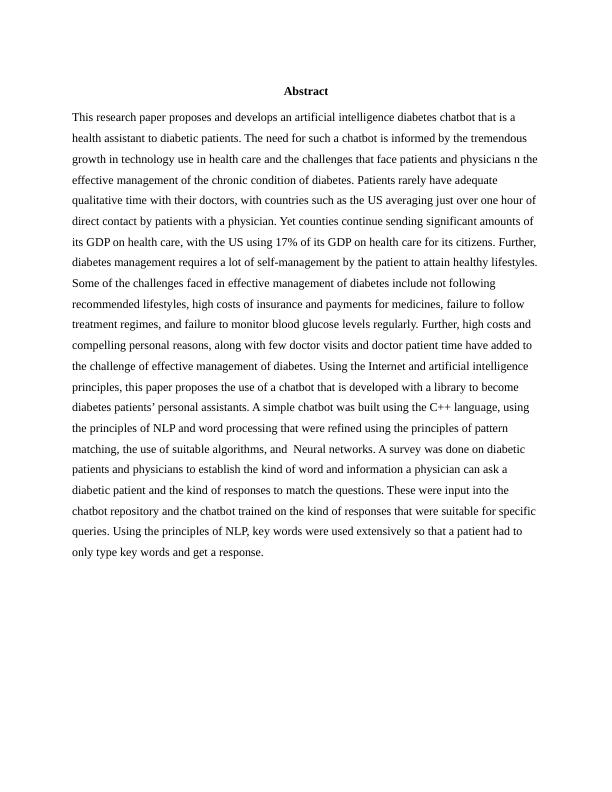
Acknowledgements

Table of Contents
Abstract............................................................................................................................................2
Acknowledgements..........................................................................................................................3
Introduction......................................................................................................................................6
Background......................................................................................................................................8
Problem Statement...........................................................................................................................8
Aim and objectives..........................................................................................................................9
Scope of the Chatbot....................................................................................................................9
Target users................................................................................................................................10
Value profile...............................................................................................................................10
Literature Review..........................................................................................................................10
Methods and Methodology............................................................................................................13
Word Processing.........................................................................................................................15
Pattern Matching........................................................................................................................17
Tokenisation:..............................................................................................................................18
Lexicon Normalization..............................................................................................................19
Syntactic Analysis......................................................................................................................20
Semantic Analysis......................................................................................................................21
Discourse Integration.................................................................................................................21
Pragmatic analysis......................................................................................................................21
Removing Stop Words...............................................................................................................22
Stemming and Lemmatization:..................................................................................................22
Algorithms.................................................................................................................................25
Naïve Bayes Classifier...........................................................................................................25
Chatbot Design..............................................................................................................................27
Building the Server....................................................................................................................27
Training Data.............................................................................................................................31
Abstract............................................................................................................................................2
Acknowledgements..........................................................................................................................3
Introduction......................................................................................................................................6
Background......................................................................................................................................8
Problem Statement...........................................................................................................................8
Aim and objectives..........................................................................................................................9
Scope of the Chatbot....................................................................................................................9
Target users................................................................................................................................10
Value profile...............................................................................................................................10
Literature Review..........................................................................................................................10
Methods and Methodology............................................................................................................13
Word Processing.........................................................................................................................15
Pattern Matching........................................................................................................................17
Tokenisation:..............................................................................................................................18
Lexicon Normalization..............................................................................................................19
Syntactic Analysis......................................................................................................................20
Semantic Analysis......................................................................................................................21
Discourse Integration.................................................................................................................21
Pragmatic analysis......................................................................................................................21
Removing Stop Words...............................................................................................................22
Stemming and Lemmatization:..................................................................................................22
Algorithms.................................................................................................................................25
Naïve Bayes Classifier...........................................................................................................25
Chatbot Design..............................................................................................................................27
Building the Server....................................................................................................................27
Training Data.............................................................................................................................31
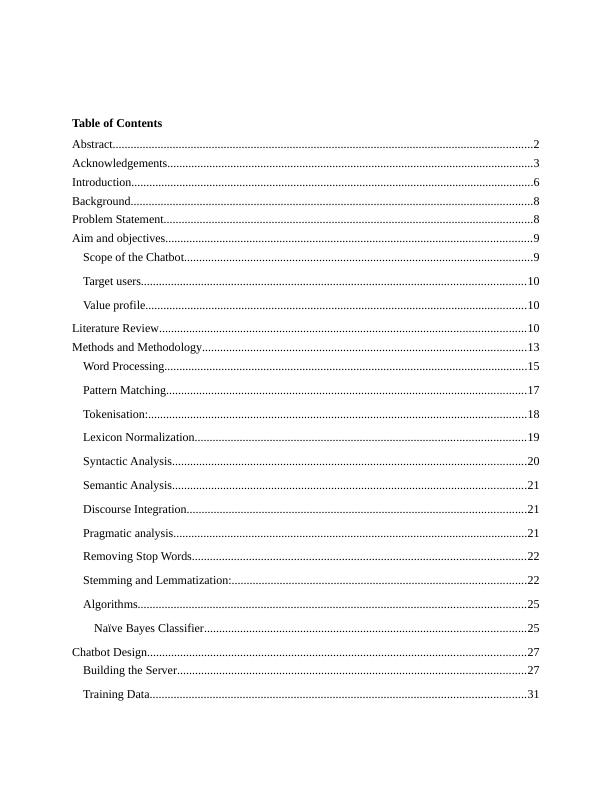
Testing........................................................................................................................................35
Conclusions....................................................................................................................................36
Recommendations......................................................................................................................37
References......................................................................................................................................38
Conclusions....................................................................................................................................36
Recommendations......................................................................................................................37
References......................................................................................................................................38

Introduction
Chatter bot, popularly termed chatbot, refers to a computer program that can undertake
conversations with human beings using textual or auditory methods. These bots are designed
such that they can simulate human behavior during communication in a highly convincing
manner. A person using the chatbot from one terminal will believe they are actually interacting
with a human being at the other end and in so doing pass the Turing Test. Chatbots are employed
in dialog systems for a variety of practical applications ranging from customer service to
acquisition of information. Some chatbots employ natural systems for language processing that
are highly sophisticated, although many still utilize simpler systems in which key words are
scanned for in an input and then replies that have the most suitable word patterns or matching
words pulled form a database. The Turing Test is a test of the ability of a machine to show
intelligent behavior, developed in the 1950 by Alan Turing (1). The intelligent behavior must be
indistinguishable from, or equivalent to, that exhibited by human beings. According to the test, a
human being can evaluate natural language conversation taking place between a machine built to
generate responses akin to those of a human, and a human being. The communication between
the machine and human, however, remains limited to text only channels, for instance, a computer
screen and keyboard so that the outcomes remain independent of the capability of the machine to
render words as being speech. If it is impossible for a human evaluator to differentiate between
the machine and human, then the machine is deemed to have passed the Turing Test. The test,
however, does not check the machines ability to provide correct answers but only the closeness
with which the machine answers resemble what would be given by a human being.
Chatbots are increasingly being used, from online shopping portals to being used by websites to
provide guidance to visitors. Although chatbots are designed for specific functions and specified
knowledge areas, they use a similar where an input is by human beings is checked against the
chatbot knowledge database. A database is required since while some chatbots can remember the
past flow of conversation, it cannot remember much or all past conversation flow. Modern
healthcare is peppered by several challenges and numerous stories of patients being failed by the
‘system’ and this has become a common occurrence. There is a huge and startling disconnect
between health care providers and patients despite the efforts that have been made to offer better
healthcare using patient centered approaches that also leverage new technologies such as
Chatter bot, popularly termed chatbot, refers to a computer program that can undertake
conversations with human beings using textual or auditory methods. These bots are designed
such that they can simulate human behavior during communication in a highly convincing
manner. A person using the chatbot from one terminal will believe they are actually interacting
with a human being at the other end and in so doing pass the Turing Test. Chatbots are employed
in dialog systems for a variety of practical applications ranging from customer service to
acquisition of information. Some chatbots employ natural systems for language processing that
are highly sophisticated, although many still utilize simpler systems in which key words are
scanned for in an input and then replies that have the most suitable word patterns or matching
words pulled form a database. The Turing Test is a test of the ability of a machine to show
intelligent behavior, developed in the 1950 by Alan Turing (1). The intelligent behavior must be
indistinguishable from, or equivalent to, that exhibited by human beings. According to the test, a
human being can evaluate natural language conversation taking place between a machine built to
generate responses akin to those of a human, and a human being. The communication between
the machine and human, however, remains limited to text only channels, for instance, a computer
screen and keyboard so that the outcomes remain independent of the capability of the machine to
render words as being speech. If it is impossible for a human evaluator to differentiate between
the machine and human, then the machine is deemed to have passed the Turing Test. The test,
however, does not check the machines ability to provide correct answers but only the closeness
with which the machine answers resemble what would be given by a human being.
Chatbots are increasingly being used, from online shopping portals to being used by websites to
provide guidance to visitors. Although chatbots are designed for specific functions and specified
knowledge areas, they use a similar where an input is by human beings is checked against the
chatbot knowledge database. A database is required since while some chatbots can remember the
past flow of conversation, it cannot remember much or all past conversation flow. Modern
healthcare is peppered by several challenges and numerous stories of patients being failed by the
‘system’ and this has become a common occurrence. There is a huge and startling disconnect
between health care providers and patients despite the efforts that have been made to offer better
healthcare using patient centered approaches that also leverage new technologies such as
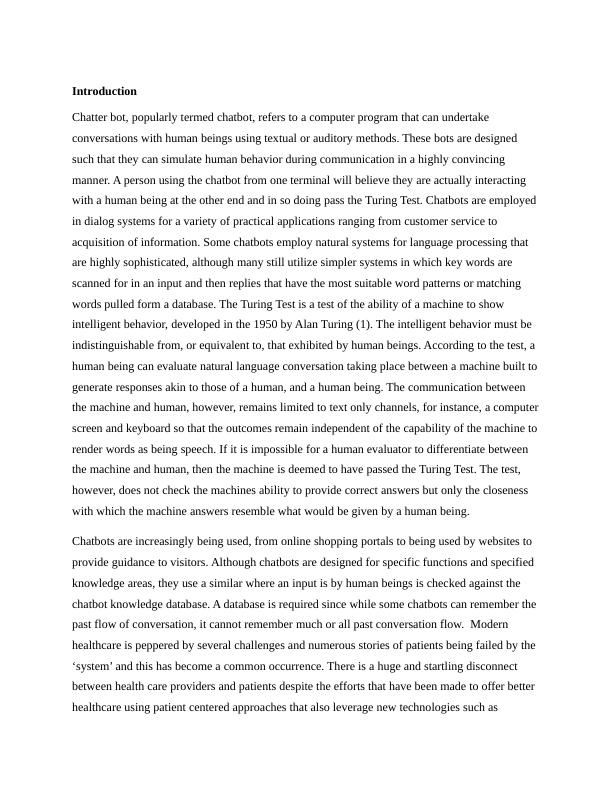
applications and mobile devices. The discrepancy between patients and physicians is still
incredibly huge. An example is in the American healthcare system where typically, a person
visits the doctor four times every year. The average patient in the US, however, just spends
about 16 minutes consulting with the physician resulting in just less than one hour of face time
engagement between the patient and physician every year, yet a year has 8760 hours! This
translates to just 0.01% time spent with the physician, yet on average, the patient spends between
10 and 20% of their yearly disposable income on health care (health insurance) and other
expenses related to their health. The US economy, for instance, uses over 17% of her combined
GDP on health care (1a).
The trend is not too dissimilar in other countries, although many have higher patient doctor visits
and interactions; Japan averages 13 visits per year, Germany 10 days, Canada 7 days, France 7
days, similar to Australia at 7 days, and 5 days for the UK. The few visits to the physician per
year and the little average time spent with the doctor begs the question as to what occurs in
between the infrequent visits to the physician? This is because health is not binary in nature
where one does well (medically) and then suddenly falls sick the next day (except in a few
cases). The biggest consumer of health resources and systems are person suffering from chronic
diseases and conditions that leave them teetering on the edge of an acute episode on a daily basis.
Such chronic conditions include asthma, heart conditions, and diabetes, among others. In the US
for example, research shows that only 5% of the total population account for 49% (almost half)
of the total expenses in health care. Further, 44% of the US total expenses in healthcare are
accounted for by 15% of health conditions that are the most expensive. Between the few and
infrequent patient meetings with physicians, the latter have little to no qualitative or quantitative
data on the daily condition of their patients. The physician and health care providers are not
aware of how well the patients comply with medication, whether they are experiencing side
effects, their general state of health and wellbeing (emotionally and physical wellbeing). The
physician is unaware whether their patients are following healthy lifestyles such as eating the
recommended foods, exercising, or even dieting. Time and resource constraints mean that
physicians do not know many things about their patients, and they have little or no time to do it.
At present, such concerns and questions remain unanswered because the physicians are only able
to see their patients after making arbitrary appointments for follow ups or if the patients’
condition deteriorates further and has to be rushed to the health care facility. However, such
incredibly huge. An example is in the American healthcare system where typically, a person
visits the doctor four times every year. The average patient in the US, however, just spends
about 16 minutes consulting with the physician resulting in just less than one hour of face time
engagement between the patient and physician every year, yet a year has 8760 hours! This
translates to just 0.01% time spent with the physician, yet on average, the patient spends between
10 and 20% of their yearly disposable income on health care (health insurance) and other
expenses related to their health. The US economy, for instance, uses over 17% of her combined
GDP on health care (1a).
The trend is not too dissimilar in other countries, although many have higher patient doctor visits
and interactions; Japan averages 13 visits per year, Germany 10 days, Canada 7 days, France 7
days, similar to Australia at 7 days, and 5 days for the UK. The few visits to the physician per
year and the little average time spent with the doctor begs the question as to what occurs in
between the infrequent visits to the physician? This is because health is not binary in nature
where one does well (medically) and then suddenly falls sick the next day (except in a few
cases). The biggest consumer of health resources and systems are person suffering from chronic
diseases and conditions that leave them teetering on the edge of an acute episode on a daily basis.
Such chronic conditions include asthma, heart conditions, and diabetes, among others. In the US
for example, research shows that only 5% of the total population account for 49% (almost half)
of the total expenses in health care. Further, 44% of the US total expenses in healthcare are
accounted for by 15% of health conditions that are the most expensive. Between the few and
infrequent patient meetings with physicians, the latter have little to no qualitative or quantitative
data on the daily condition of their patients. The physician and health care providers are not
aware of how well the patients comply with medication, whether they are experiencing side
effects, their general state of health and wellbeing (emotionally and physical wellbeing). The
physician is unaware whether their patients are following healthy lifestyles such as eating the
recommended foods, exercising, or even dieting. Time and resource constraints mean that
physicians do not know many things about their patients, and they have little or no time to do it.
At present, such concerns and questions remain unanswered because the physicians are only able
to see their patients after making arbitrary appointments for follow ups or if the patients’
condition deteriorates further and has to be rushed to the health care facility. However, such
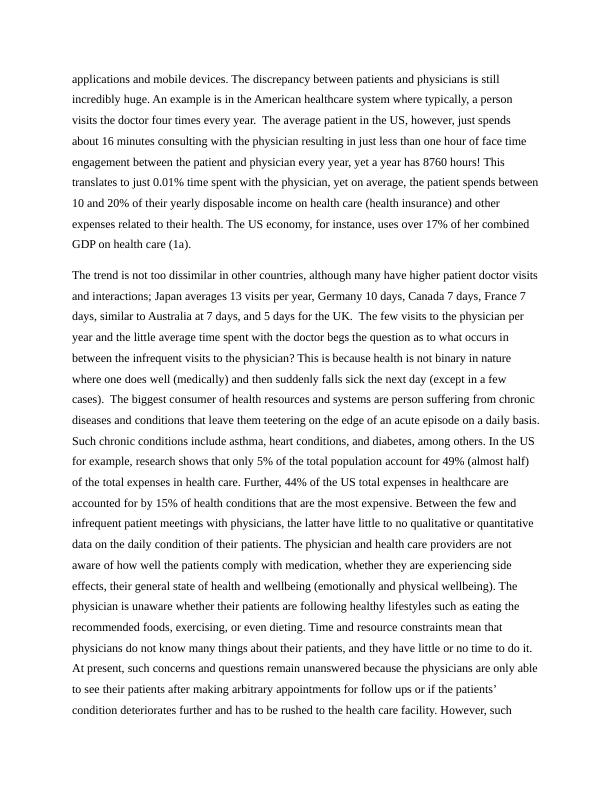
interventions are usually almost too late and generally, only 13% of physicians are available for
telephone communication with patients. This state of affairs also mean that patients may feel
disconcerted from the care givers resulting in their disengagement from their therapy.
Background
Generally, diabetes is a disease condition that happens when the blood sugar (blood glucose)
becomes too high. The main source of energy for the human body is glucose obtained from
ingested food. In the human body, the pancreas releases insulin hormone that helps get glucose
into the body cells from the consumed food for use as energy. However, sometime the body fails
to make sufficient insulin or none at all or in some cases, fails to properly utilize insulin leading
to the glucose remaining in the persons’ blood and failing to reach their cells. With time, too
much glucose in the blood causes health problems and diabetes has no cure. Because of its
nature, daily routine and lifestyle plays a very big role in its management. The effective
management of diabetes requires awareness, by both the patient and the physician; as well as
how the daily factors of daily routines and lifestyle can be controlled. Keeping persons’ blood
sugar levels at what the physician recommends can be a huge challenge since several factors and
things lead to changes in one’s blood sugar levels in unexpected ways. The food that people eat
should be healthy since healthy eating forms one of the cornerstones of healthy living, even for
those without diabetes. Diabetics must know how food affects their blood sugar levels since it is
not just the type of food consumed that affects blood sugar but the amounts eaten as well.
Problem Statement
As discussed in the introduction, doctor patient interactions are few; doctors have no way of
knowing the daily conditions of their patients while the patients are left largely on their own.
Further, the few times that doctors interact with patients mean that qualitative advice on such
issues as diet, exercise, meals, and drink that can help the diabetic patient better manage their
condition is way too little. Diabetes poses some well-known but serious medical/ health risks to
sufferers that include orthopedic problems, peripheral circulatory problems, chronic ulceration,
stroke, high blood pressure, high triglycerides, and cholesterol. Patients must seek counsel from
their health providers to obtain essential guidance on how to look after themselves to control
their diabetic condition as well as better control related conditions to attain optima health. The
telephone communication with patients. This state of affairs also mean that patients may feel
disconcerted from the care givers resulting in their disengagement from their therapy.
Background
Generally, diabetes is a disease condition that happens when the blood sugar (blood glucose)
becomes too high. The main source of energy for the human body is glucose obtained from
ingested food. In the human body, the pancreas releases insulin hormone that helps get glucose
into the body cells from the consumed food for use as energy. However, sometime the body fails
to make sufficient insulin or none at all or in some cases, fails to properly utilize insulin leading
to the glucose remaining in the persons’ blood and failing to reach their cells. With time, too
much glucose in the blood causes health problems and diabetes has no cure. Because of its
nature, daily routine and lifestyle plays a very big role in its management. The effective
management of diabetes requires awareness, by both the patient and the physician; as well as
how the daily factors of daily routines and lifestyle can be controlled. Keeping persons’ blood
sugar levels at what the physician recommends can be a huge challenge since several factors and
things lead to changes in one’s blood sugar levels in unexpected ways. The food that people eat
should be healthy since healthy eating forms one of the cornerstones of healthy living, even for
those without diabetes. Diabetics must know how food affects their blood sugar levels since it is
not just the type of food consumed that affects blood sugar but the amounts eaten as well.
Problem Statement
As discussed in the introduction, doctor patient interactions are few; doctors have no way of
knowing the daily conditions of their patients while the patients are left largely on their own.
Further, the few times that doctors interact with patients mean that qualitative advice on such
issues as diet, exercise, meals, and drink that can help the diabetic patient better manage their
condition is way too little. Diabetes poses some well-known but serious medical/ health risks to
sufferers that include orthopedic problems, peripheral circulatory problems, chronic ulceration,
stroke, high blood pressure, high triglycerides, and cholesterol. Patients must seek counsel from
their health providers to obtain essential guidance on how to look after themselves to control
their diabetic condition as well as better control related conditions to attain optima health. The
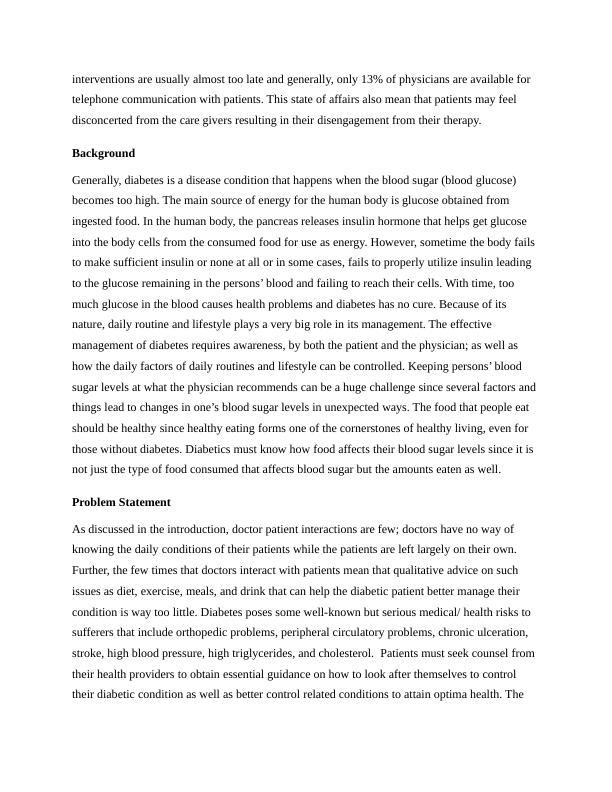
End of preview
Want to access all the pages? Upload your documents or become a member.
Related Documents
Artificial Intelligence Assignment Solutionlg...
|11
|3738
|225
